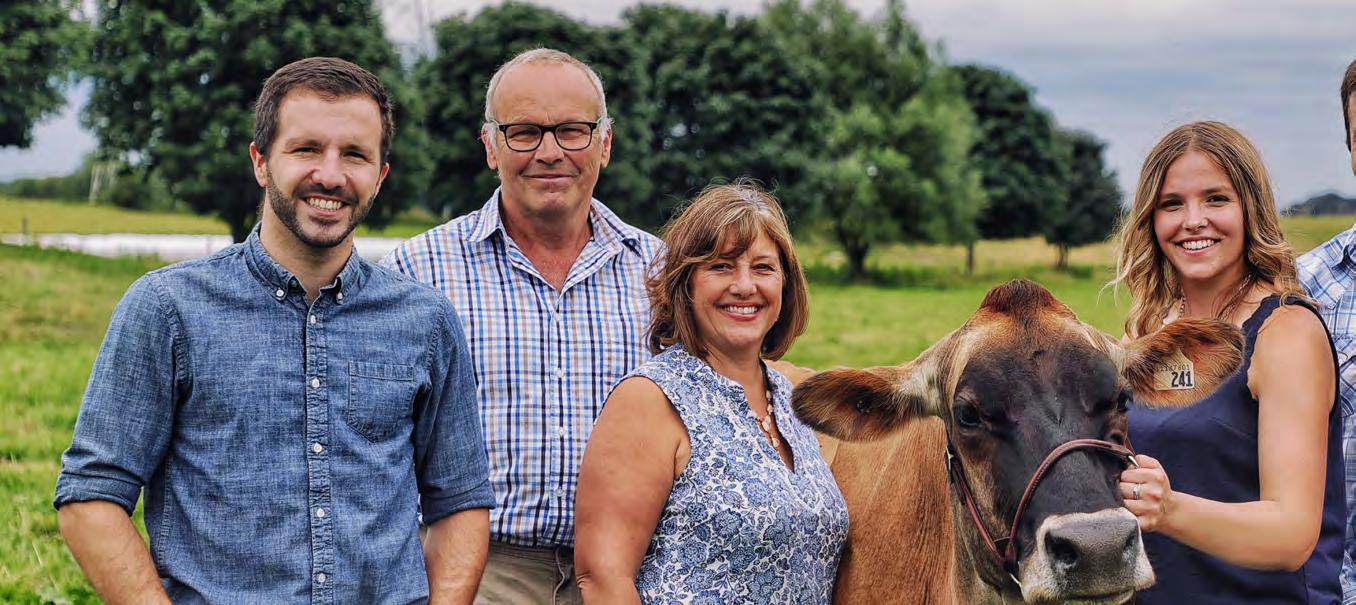
9 minute read
On-farm processing
from Late Winter 2022
by MilkProducer
ON-FARM PROCESSING HELPS FARM FAMILIES DIVERSIFY
Two Ontario dairy farm families share their recent journeys to open their own processing plants, reflecting a strong provincial trend
By Treena Hein CONTRIBUTOR
2016 with a small pilot and has supported 91 participants to date. Previous to its implementation, producers received various types of assistance from DFO staff.
“Our role is to support them from start to finish by providing guidance in the process, requirements, regulations, procedures and so on,” explains Alan Grebinski, DFO’s director of business & educational development. “Other integral support comes in the form of mentoring through developing a business plan, a pitch deck, sell sheets, marketing advice, go-to-market strategy, co-packer relationships, plant setup and design.” Several graduates have also accessed one or more matching grants from DFO to aid in growing their businesses, he adds.
The Ontario Ministry of Agriculture, Food and Rural Affairs (OMAFRA) also helps guide producers through the start-up process and required regulations.
“Once you begin the process of licensing an on-farm processing plant, OMAFRA will be with you every step of the way,” says Rick Bond, dairy food safety adviser at OMAFRA. Once applicants notify OMAFRA of their interest in on-farm processing, the applicant is sent licence and permit applications where they’ll have to describe their overall farm operation and proposed processing plant, Bond adds. Included in the package are OMAFRA's guidelines and copies of relevant regulations.
After the completed applications are received, OMAFRA will begin working with the client to get started, Bond explains. “This will include on-site visits to ensure they are meeting all the relevant
Delicious and healthy dairy products made right on the farm— that’s the idea behind the many small on-farm processing plants getting started across Canada right now. In Ontario, in particular, the number of these plants is growing at a rapid pace.
Over the last five years, three have opened their doors in Ontario, bringing the current total to 17, with more expected to begin operating in the next 24 months, according to Dairy Farmers of Ontario (DFO) staff. These processing farms are located across the province and produce milk and other products, such as chocolate milk, butter, yogurt and cheese. The smallest plant processes 14,000 litres of milk per year and the largest processes 825,000 litres. All the farms continue to ship milk into the provincial pool.
When you look at the factors behind this trend, it makes perfect sense. First, the desire for locally-produced foods has never been stronger. Second, on-farm processing is an excellent way for farm families to diversify and expand their operations so they can support the next generation without purchasing additional quota or land. It’s also a way for family members to innovate in terms of making and marketing products that are artisanal, vintage or another category.
Of course, adding processing to a dairy farm is a big step, but those starting out have access to many resources, such as DFO’s Start Up & Scale Up Innovation Program. It’s open to any entrepreneurs who want to start milk processing or expand their business. It started in

SARGENT FAMILY Dairy Ltd. (left to right)- Bruce, Tim and Sharyn (parents), Melyssa, Daniel, Stephynie and Benjamin.
regulatory requirements at every phase of the project right up until the final inspection preceding the issuing of the operating licence.” Following licensing, plants must undergo inspection by an OMAFRA officer, usually annually.
When asked about parts of the process that may require more attention than expected, Bond notes having a good marketing plan is important, and producers should be aware sourcing new or used equipment for a smaller scale on-farm processing plant can be challenging. He adds processing is more labour-intensive than some farmers might expect and “in many cases, as much or even more time is spent cleaning and sanitizing than making the products.” He highly recommends interested farmers visit and engage with those who already run on-farm processing plants to learn the ropes.
DFO relations specialist Alex Hamilton also advises talking to other on-farm processors to gain valuable knowledge. He agrees a good market analysis is critical and thinks farmers should consider purchasing equipment that can handle potential future growth.
Bond says the entire permit process timeline could take 12 to 18 months, depending on several factors. Hamilton cautions applicants should expect the process to take longer than they initially think it will. “We tell them that it will take time,” he says, “likely a year or two of planning to prepare for the build. Overall, producers need to research their market, develop a business plan, complete the local permitting process and arrange financing. Once you’ve TAMARA BIRNEY is a local high school student who works in production and helps staff the store.
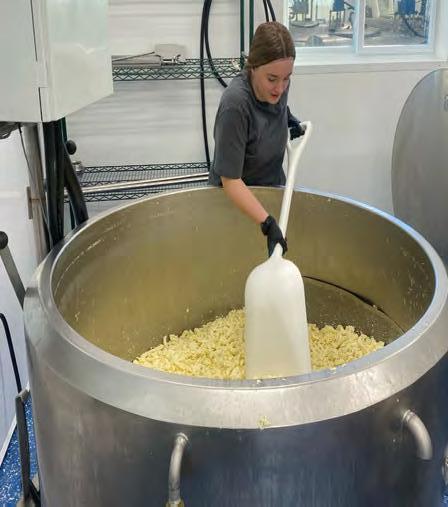
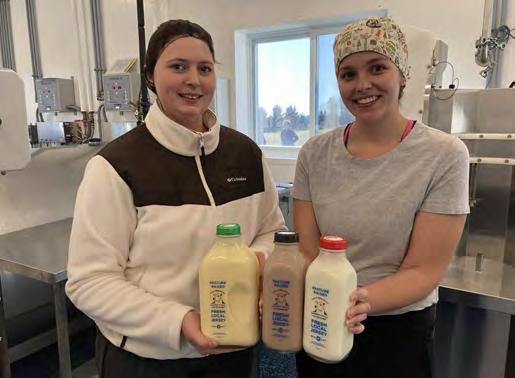
MELYSSA SARGENT runs the processing plant and Lily Bullock, a family friend, helps with production.
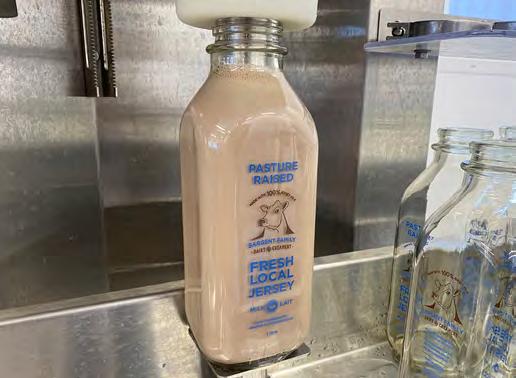
MILK SALES, chocolate milk and cheese curds have been going very well, and the newly-launched eggnog was a bit hit during the holidays.
It’s (on-farm processing) a new revenue stream that will support us and support farm business growth … It also made good sense for us in that I have a strong marketing background and we are situated in a region with phenomenal interest in local products.
- Bruce Sargent
LICENSING A DAIRY PLANT
Visit these websites for more information:
http://www.omafra.gov.on.ca/english/ food/inspection/dairy/page-2.htm
Dairy Farmers of Ontario’s (DFO) Start Up & Scale Up Innovation Programs https://new.milk.org/In-the-Community/ Innovation-Programs
On-farm processing helps farm families diversify, cont’d from page 19 built the plant, it’s hard to make changes after. There will be lots of questions that need to be answered and there is lots to understand.”
JERSEY PRODUCTS A HIT
Sargent Family Dairy in Bolton, Ont., opened in June 2021. The farm is also home to a pedigree Jersey herd of worldwide fame and has 60 cows in the milking herd. Before the processing plant opened, parents Tim and Sharon Sargent ran the farm business with the help of their children Daniel, Melyssa and Benjamin. Sibling Stephynie is an optometrist who keenly supports the farm, while Bruce runs his own marketing firm.
In recent years, the family discussed expansion options that would increase profits and allow Bruce to derive income from the operation. “It’s a new revenue stream that will support us and support farm business growth,” Bruce says. “It also made good sense for us in that I have a strong marketing background and we are situated in a region with phenomenal interest in local products. In addition, Melyssa had interest in learning how to make cheese and operate the creamery.”
In marketing Sargent Family Dairy products, the uniqueness of their Jersey herd plays a strong role. “There’s a strong connotation to old-fashioned milk with the Jersey cow,” Sargent says. “The milk also has a much higher fat content than you see with other breeds, so it’s smoother and richer, which people love.”
The permit process wasn’t overly onerous, he notes, but “COVID added quite a bit to OMAFRA’s paperwork requirements. It also prevented us from visiting other on-farm creameries to see how things worked and understand what OMAFRA was referring to in terms of specific code requirements,” he says. “But once the inspector visited and showed us, it was very fast to clear these things up. Our plumber came up with an immediate solution for one particular building code requirement and for a nominal price, so we were very grateful for his expertise.”
Sales for their milk, chocolate milk and cheese curds have been going very well, and the newly-launched eggnog was a bit hit during the holidays. “The bulk of sales for all products is through our on-farm store, and we also sell to about a dozen other independent markets,” Bruce says. “We’ll continue to grow that number over time.”
Reflecting on the whole journey, Bruce adds that “it’s been a lot more work than we were expecting. That can’t be underscored, and we look forward to reaching a point where we can hire more help, but we’re all very happy with how it’s gone.”
COMMUNITY CONNECTION
Mistyglen Holsteins in Belmont near London, Ont., with a milking herd of 55 cows, will also be the official home of Mistyglen Creamery in early 2022. The Pettit family first settled in the area in 1816, and the current location of Mistyglen was purchased in 1957 by Murray Pettit, the father of current owners Tom and Suzanne Pettit. The brother and sister duo gets assistance with the farm’s daily operations from Tom's wife, Kris, and their teen daughters Maddie and Kadie.
The journey to processing began quite a few years ago when the family started looking at on-farm business options that would allow Kris to work on the farm full time. A creamery business really
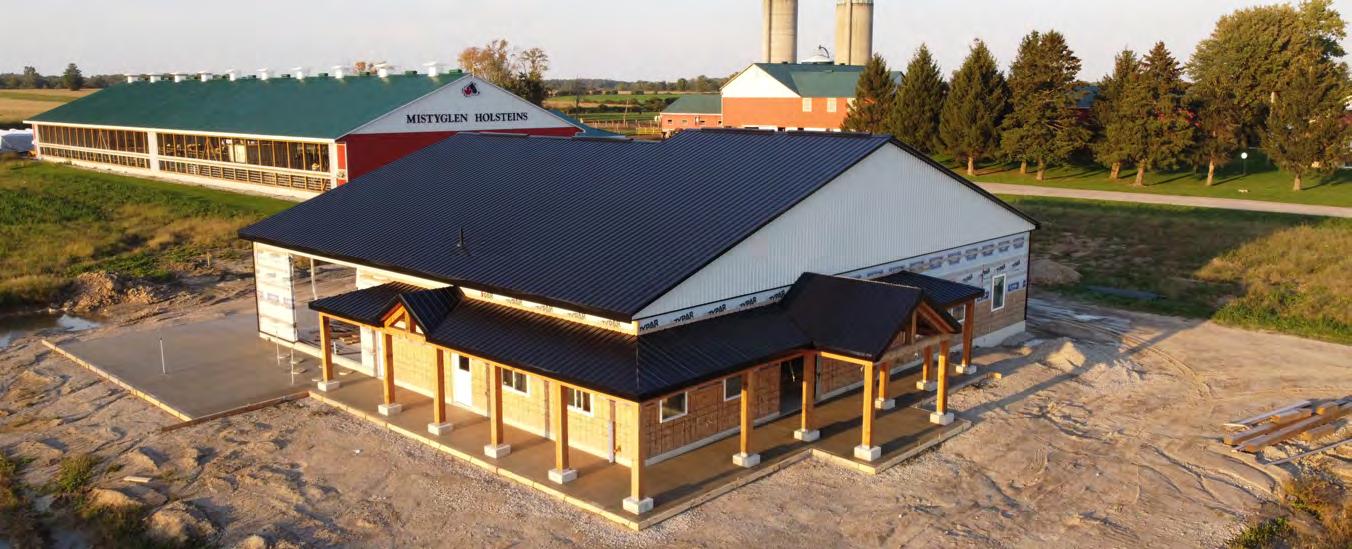
We’re very passionate about health, quality, transparency and education, and to get back to the roots of dairy. We also think onfarm processing is important for food security. The flooding in British Columbia and watching other onfarm processors become saviours to their communities is a glaring example of why local access is pivotal.
- Kris Pettit
TOM AND KRIS PETTIT with daughters Maddie and Kadie, and family dog.

excited Kris so the Pettits decided to join DFO’s Innovation Program in 2016.
However, at that point, they weren’t sure which value-added products to go with. The whole idea was shelved for a few years, but during the pandemic, it came up again. The Pettit’s dairy barn had recently been destroyed by a tornado, and with a new barn to build, they decided the time had come to invest in a processing plant and retail store. Construction is expected to be complete in January and they will begin with selling milk, chocolate milk, yogurt and cheese curds. mitting that slowed the start of the build.” She adds there were also some construction delays during fall 2021, when the wet weather made excavation difficult.
Beyond being a way to allow Kris, a long-time geriatric nurse, to be on the farm full time, processing is also an important way to connect the farm with the community. In addition to selling yogurt at their store when ready, the Pettits are working hard to distribute their product to marginalized and older people.
“It will be a full-fat, probiotic yogurt that will assist older people, in particular, with gut health and handling various chronic diseases,” Kris explains. “We’ve been working with Fanshawe College and Western University to develop the right recipe. We’re very passionate about health, quality, transparency and education, and to get back to the roots of dairy. We also think on-farm processing is important for food security. The flooding in British Columbia and watching other on-farm processors become saviours to their communities is a glaring example of why local access is pivotal.”
Treena Hein
is an award-winning contributor to many publications in Canada and beyond, specializing in business and technology issues in the sectors of agriculture, food, manufacturing and more.








